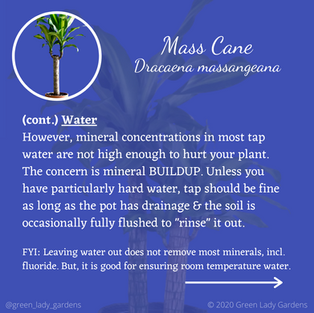Dracaena Care & Winter Care Tips
- Green Lady Gardens
- Dec 10, 2020
- 2 min read
Updated: Nov 17, 2023
During this time of the year, quite a few people ask me what the heck is up with their Dracaena sp.
While Dracaena sp. are generally a hardy bunch, they can get a little testy in the winter for a number of reasons. The problems are mostly the same: The leaves either won't stop yellowing or they won't stop browning.
If this is happening to your Dracaena sp., read this post, assess your plant's symptoms, & make the necessary adjustments. Don't forget to clean your plant up with a leaf trim or, if you need to, a leaf hack. The mass cane (or corn plant) is used as the headliner of this slideshow but the information applies to other Dracaena sp. as well.
Save this slideshow from our Instagram account!
Common Reasons for Winter Problems
- Overwatered because the light has shifted & you
haven't decreased watering.
- Underwatered because your place is hotter &
you haven't increased watering.
- Low humidity.
- Cold draft or heat vent.
- Water is too cold. (You might be surprised how
much colder your water is in the winter!)
Light
Semi-shade - bright indirect. Faded coloring = light is too bright. Semi-shade is just fine but growth is slower.
Temperature & Humidity
65°-80°. Avoid drafts (including thin windows) & heat vents. Brown leaf tips = low humidity. This is a common winter problem.
Water
Allow to dry 50% & water with room temperature water. Underwatering = brown leaf tips. Overwatering = leaves pale, sag, yellow, develop brown spots on the edges, or develop brown tips with a ring of yellow. Cold water = yellow leaves. Dracaena are sensitive to mineral salts (calcium, fluoride, chlorine, etc.) found in tap water. However, mineral concentrations in most tap water are not high enough to hurt your plant. The concern is mineral BUILDUP. Unless you have particularly hard water, tap should be fine as long as the pot has drainage & the soil is occasionally fully flushed to "rinse" it out.
FYI: Leaving water out does not remove most minerals, incl. fluoride. But, it is good for ensuring room temperature water.
Soil & Potting
Loose, fast draining soil with a generous amount of perlite, sand, or rocks is a must.
Pruning & Propagation
Lower leaves fall off w/ age. Cutting a cane = remaining stalk branches & re-sprouts. The cut off top piece can be propagated.



















Comments